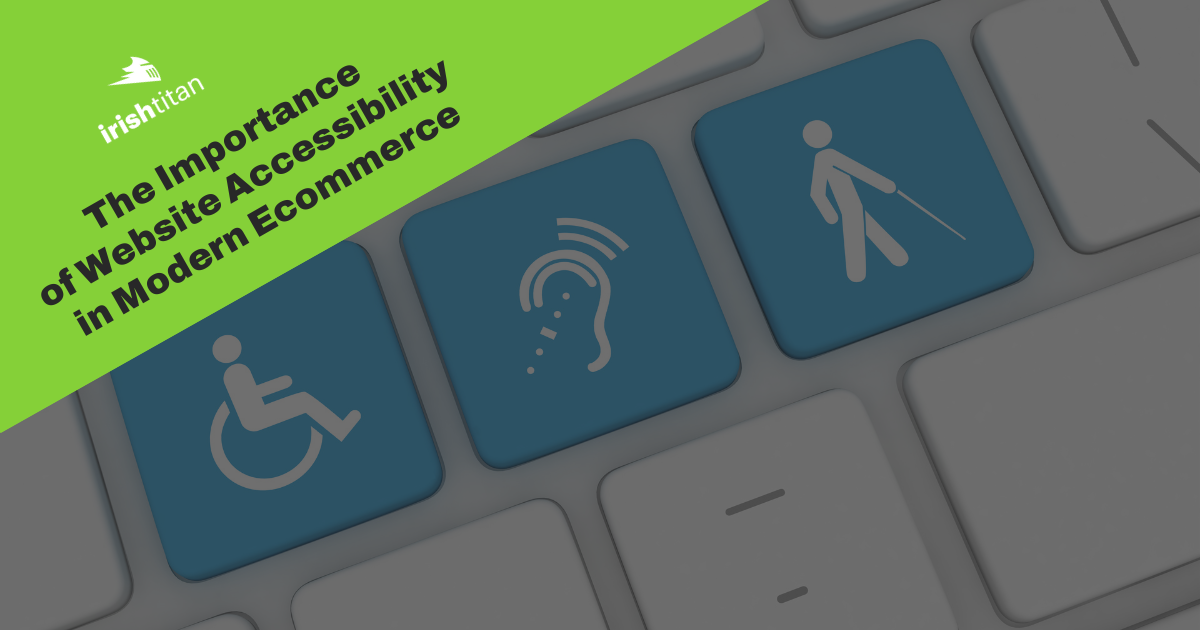Tailoring Your Ecommerce Strategy: Custom Solutions vs. Native vs. Apps
When it comes to building ecommerce experiences, merchants face a critical decision: should they invest in a fully custom solution, rely on native platform features, or integrate third-party apps? Each option offers unique advantages and challenges, and the best choice often depends on your needs, budget, and long-term goals. Over 20 years of Irish Titan, we've tackled this question countless times, and our experience has revealed some key learnings. Drawing on insights from Monica Shieh, a seasoned Software Engineer at Irish Titan, this guide examines these three approaches and provides actionable advice to help you land at the right decision. Whether you value customization, speed, or cost-efficiency, we’ll help you find the right fit for your ecommerce goals.
1. Custom Solutions: Tailored Solutions for Unique Needs
A custom solution involves building entirely new functionality or systems from scratch, tailored specifically to meet exacting business needs that aren’t covered by existing platform capabilities. As Monica explains, "We create everything step by step, carefully constructing it to seamlessly integrate with platforms like Shopify, BigCommerce, or Shopware."
When we asked Monica about her favorite custom project at Irish Titan, she highlighted a recent solution developed for TC Farm. TC Farm was looking for a fully custom integration to BigCommerce because of a highly complex back end and multi-store approach, the project proved incredibly rewarding. Monica described it as "something entirely new—nobody had done it before, and we made it happen. All the vision, time, risk, and resources invested really paid off in the end!"
Pros:
- Complete control over functionality and design: Provides greater control over data, user experience, and how features integrate with other systems.
- Tailored to fit your exact business use cases: Offers full flexibility to build exactly what your business requires, fitting unique workflows, customer experiences, and operational processes
- Scalable for long-term growth: Your vision of the future of your business means you’re free to build a custom solution that will grow right alongside you enabling your ecommerce site to evolve as your business expands. With the ability to develop unique features tailored to your specific needs, it allows your brand to stand out from competitors relying on standard, off-the-shelf solutions. This flexibility ensures your site can adapt to new market demands and innovations, providing a competitive edge that supports sustained success.
Cons:
- Overall, it’s usually the most expensive option: Custom development can be expensive and time-consuming, requiring specialized developers, including ongoing maintenance costs.
- Higher initial costs and extended development timelines: Developing a custom solution demands significant preparation and research. This often necessitates proof-of-concept (POC) testing before full development begins to minimize risks and confirm feasibility. This groundwork helps create a more robust and effective final product, though it does add time and complexity to the project.
- Continued management for updates or fixes: Custom code requires regular maintenance, security updates, and potential adjustments as the platform evolves. Platform updates can quickly break customizations, meaning each upgrade can take your solution down or require costly adjustments.
- Challenging to transition to new systems, vendors, and employees: Monica emphasized the critical need for transparency and documentation regarding the challenges of managing custom solutions. As businesses inevitably evolve, add new employees, vendors, or partners, complications can arise with custom apps. The original development partner typically retains in-depth knowledge of how the custom solution was built and functions. If proper documentation, onboarding, and offboarding are skipped, expensive solutions can quickly spiral. This leaves the business in a difficult position—either relying on the new partner to reverse-engineer the solution, which can be expensive and time-intensive, or opting for an entirely new solution. Working with quality agencies and vendors that are open and transparent about what and how they’re building can cost more upfront but can pay off dividends in the long term.
This option is ideal for businesses with unique requirements that native features or apps can’t fully address. Decide on your mission-critical requirements first, the items you absolutely must have, then vet all existing apps or pre-built features with those requirements. If no app meets those requirements, start looking into custom solutions from a quality partner.
For example: We recently charted a course alongside our client, gathering must-have requirements, and vetted all apps. After no app met those standards, we developed a custom Partner Connections solution from the ground up. Managing both the front-end and back-end to create a tailored experience that met the unique needs of the business. In another case, we integrated custom APIs into a client's system to ensure seamless data retrieval and functionality, addressing specific operational requirements that were not covered by standard solutions.
2. Native Features: Built-In Power with Simplicity
Native features refer to built-in functionality provided by platforms like Shopify or BigCommerce. These are pre-configured tools designed for ease of use.
Pros:
- Faster implementation: Pre-built and integrated into the platform. Since the features are already part of the system, there’s no need for extensive customization or third-party integration, which speeds up setup. This allows businesses to launch quickly with minimal development time, making it an ideal choice for those seeking an efficient, straightforward solution without complex setup requirements.
- Lower initial costs: Since they are included in the platform, there’s generally no additional cost, making them cost-effective for core ecommerce functions.
- Guaranteed platform compatibility: Designed to seamlessly integrate within the platform, ensuring compatibility and performance. This built-in functionality guarantees that it will work as expected, reducing the risk of issues and offering reliable performance
- Reliable Maintenance & Support: Platform providers regularly maintain and update these features, ensuring they stay up-to-date and secure. There’s no real concern that a platform will put out an update that would break the connection.
Cons:
- Limited flexibility for customization: Adding extra features beyond the basic functionality can quickly reveal the limitations of the platform. In Monica’s experience, many clients have faced dissatisfaction with the out-of-the-box features, which often don’t meet their specific needs. These limitations can restrict the ability to fully customize and scale their solution, making it challenging to address unique business requirements.
- Often fails to meet specific business needs: If you have a more customized business need or use case, there is always going to be something that a client wants in addition to that the native feature cannot do.
- Dependency on the platform’s roadmap (e.g., deprecated features): Any changes or improvements depend on the platform’s development roadmap, which may not always align with the business’s needs or speed.
3. Apps: Plug and Play Versatility
Apps provide additional functionality by integrating third-party solutions into your ecommerce platform. These are typically built by developers outside the platform, offering a middle ground between native features and full customization.
Pros:
- Scalable for evolving needs: Apps can grow with your business as it evolves, easily adding or adjusting features to meet new demands. This flexibility allows businesses to adapt quickly without the need for a full redevelopment.
- Quick & easy installation: Apps can be installed in minutes, making it easy to add functionality without extensive development that custom solutions require.
- Adds specialized functionality: There are apps for almost any function, from SEO tools to email marketing, and these are usually designed to integrate seamlessly with the platform.
- Lower development requirements: They generally don’t require custom code, making them accessible to non-technical users and reducing development costs.
Cons:
- Limited control over updates and compatibility: App performance depends on the app developer’s maintenance, so issues may arise if the app isn’t regularly updated.
- Risk of dependency on third-party developers: From an agency perspective it's hard to partner with app vendors, which causes communication and understanding limitations. You’re now managing both the platform and app roadmap. Apps may not always work well with each other, especially if they overlap in function, which can lead to conflicts and performance issues.
- Additional costs for licensing or subscriptions: Many apps come with subscription fees that can add up over time. While these might be less than custom development, they can be eye-watering-ly expensive for hyper-focused or customizable apps.
Apps often work well when paired with native features, but over-reliance on them can create problems. As Monica Shieh, our Development Specialist, noted, “You are working with developers who built an app on top of a platform so they can customize and do with it what they want, but it's in their control and not yours. So you are looking at two third parties you have to deal with. The platform AND the app developer.
How does Irish Titan decide and recommend the best solution?
At Irish Titan, weighing these priorities and evaluating the right solution for our clients is our bread and butter. It’s what we’re best at. Our 20 years of ecommerce experience means we’ve seen every custom solution, third-party app, and platform interaction out there*. We assess options based on flexibility, scalability, and cost, helping our clients decide which factors are most important to them. Whether they prioritize customization, quality, or budget, this is the deciding factor that we ultimately use to make the proper recommendations. Once that decision is made, we’re building responsibly, with plenty of documentation, and discussion.
*Probably.
Key Considerations to help you make a decision:
The best solution depends on your priorities.
Budget: Clients often prioritize cost for 99% of their build, often favoring native or app-based solutions. However, a custom solution can pay off for those with higher budgets or who value tailored functionality
Monica highlights that cost is often the most significant consideration. “Most clients are budget-conscious and hesitant to invest heavily in custom solutions, though some prioritize functionality and quality when the budget allows.” She emphasized that while custom builds are ideal when the budget permits, relying on apps or native features can lead to issues as the business scales.
Flexibility: Custom solutions shine when business requirements evolve frequently, while native features work best for stable, straightforward needs.In Monica’s experience, native functionality works well for small businesses in the early stages, particularly when their business model is simple and they lack a clear direction or long-term vision. However, for more established businesses with growing or complex needs, relying solely on native features or apps may not be sufficient. These businesses are likely to encounter additional use cases, making a custom solution a better fit to ensure scalability and flexibility. Therefore, for these businesses, a custom solution is typically the better recommendation.
Time to Launch: Native and app solutions are faster to implement, while custom builds take more time but deliver higher precision.Native and app solutions are typically quicker to implement than custom solutions, which take more time. However, that extra time spent on a custom solution is justified by the thorough process involved—research, planning, building, end-to-end testing, and deployment. While it takes longer, a custom solution often delivers exactly what is needed, and in Monica’s experience, the effort has consistently paid off for clients in the long run.
Long-Term Growth: For scalability, a balanced approach—leveraging native features and apps with minor customization—often proves effective, but is not always advantageous.Monica sees a key benefit in custom solutions because they allow the agency to maintain full control over the functionality. When something breaks or needs updating, the agency can immediately address the issue without waiting for a vendor response. With native features or third-party apps, businesses are at the mercy of the vendor’s timeline and decisions. If updates or changes aren’t made, it can cause significant setbacks, leaving the business scrambling for alternatives that may not always work as effectively. This is a critical point, as it ties back to one of the main drawbacks of using native features and third-party apps: the reliance on platform and app developers. For instance, if a platform like Shopify decides to deprecate a feature, it introduces significant complexity. Not only does the feature become obsolete, but it can also impact other integrated apps. The result? Your business may face disruptions, forcing you to search for alternatives that may not always align with your original needs, costs, or expectations.
At the end of the day, these are the 3 things to keep in mind.
The choice between custom, native, and app-based solutions depends on many varying factors. Consider these when evaluating the strategy that best fits your needs:
- If flexibility and uniqueness are priorities, custom solutions are worth exploring, especially if the company has the resources for development and maintenance
- If the goal is to keep costs low and reduce complexity, native features are often sufficient for essential functions.
- If balancing customization with cost is the compromise you need, third-party apps are an easy way to extend capabilities without investing in custom builds.
At Irish Titan, we focus on helping clients navigate these decisions. Whether you're starting from scratch or scaling an existing platform, our team ensures you have the tools and insights to make the best choice.
Ready to take your ecommerce solution to the next level? Whether you're considering a custom implementation, relying on native features, or integrating apps, it's important to choose the option that best aligns with your business goals. Let us help guide you through this decision-making process.
Trust us, you’re gonna want this in your inbox.
Join the Irish Titan sphere of influence. We'll send a couple emails a month. No trash, no spam, just the shenanigans we get up to.
More reads





More from Musings...

2024 truly wrapped. While some 'Wrapped' summaries (cough Spotify cough) jump the gun in early December, we took the time to gather, survey, and reflect on the entire year.

By Nate Levine, User Experience Engineer at Irish Titan. Heat maps are a type of data visualization tool that illustrates how users interact with your website. They use color coding to represent the level of activity across different parts of your site—think of it like a weather map, but instead of showing temperature, it shows user engagement. The hotter the color (reds, oranges), the more active the engagement with that section, while cooler colors (blues, greens) indicate less interaction.

Email marketing is the unsung hero of ecommerce success. Automated email flows are not just a "nice-to-have"— “they are the backbone of your marketing strategy” according to our Designer and resident Klaviyo Queen, Elissa Boll. Flows help consistently generate passive income and keep your brand top of mind for existing and potential customers.
